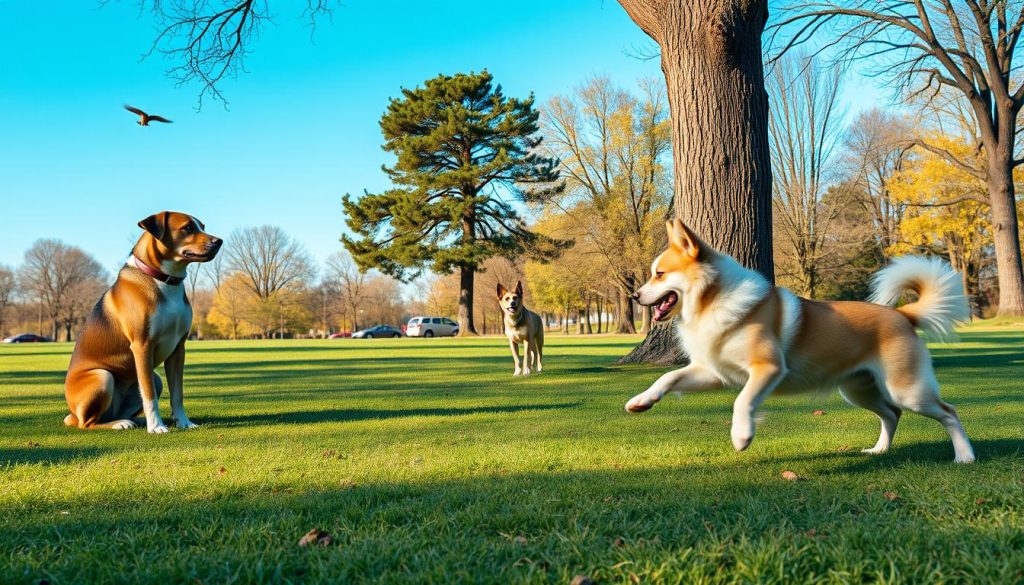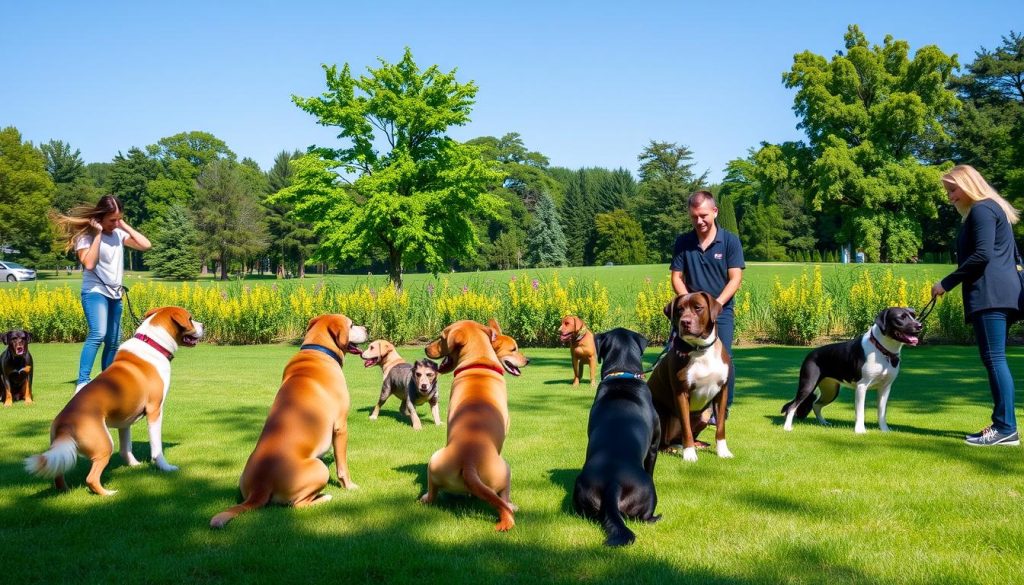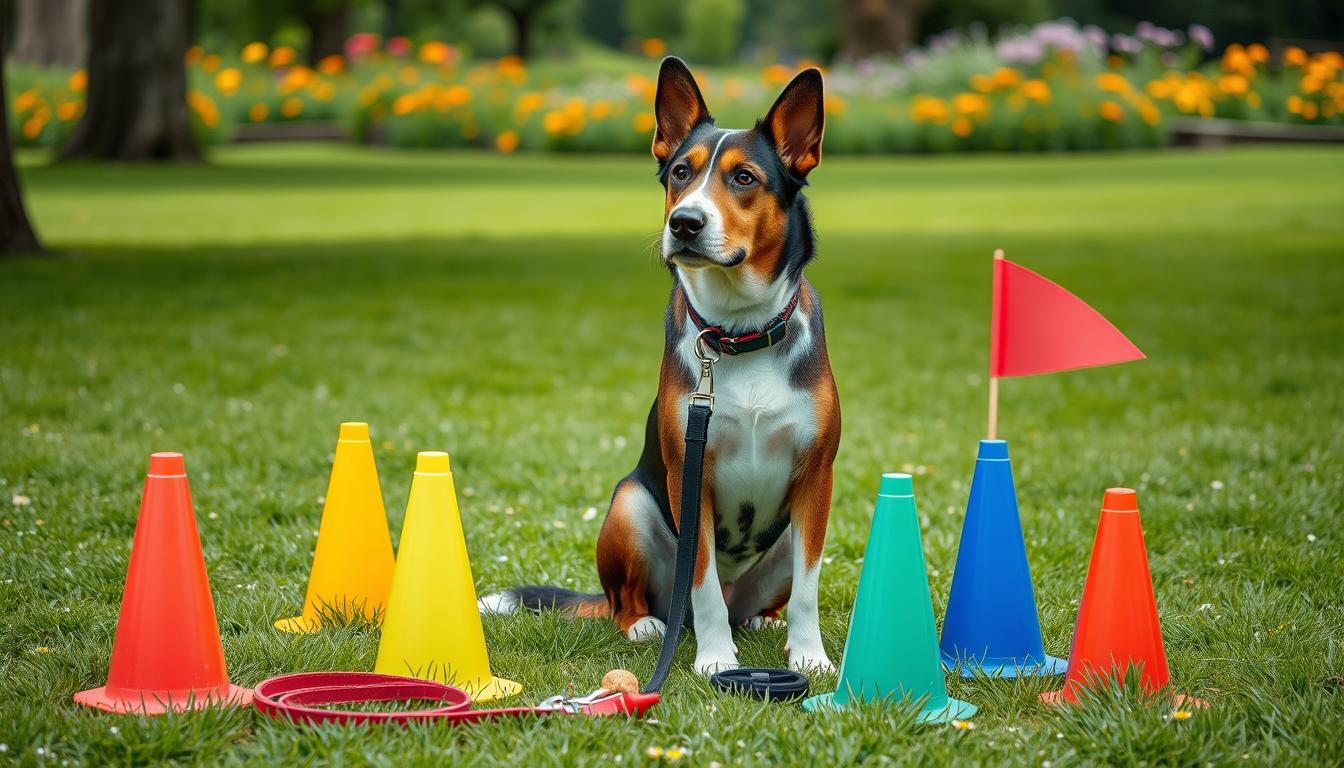As a proud pet owner, I know how vital training is for your furry friend. Whether you’ve just brought home a new pup or want to strengthen your bond, learning basic commands is key. In this guide, I’ll share easy techniques and strategies to start your dog’s training journey.
Obedience training is essential for a well-behaved dog. Teaching your pup to sit, stay, and come sets clear boundaries and deepens your bond. These basic commands are the foundation for more advanced training, making your dog a well-mannered and responsive friend.
In this article, we’ll explore why obedience training is important. I’ll share tips for a strong bond with your dog and guide you through teaching the basic commands. By the end, you’ll have the skills and confidence to start a rewarding training journey with your pup, leading to a lifetime of companionship and good behavior.
The Importance of Obedience Training for Dogs
Obedience training is key for dog owners. It brings many benefits for both you and your dog. It strengthens your bond, sets clear rules, and prevents bad behavior.
Building a Strong Bond with Your Furry Friend
Training your dog helps build a stronger bond. You work together to learn commands and solve problems. This deepens your understanding and appreciation for each other.
This bond makes your daily life better. Your dog becomes more attentive and responsive to you.
Establishing Boundaries and Preventing Behavioral Issues
Training teaches your dog what’s expected of them. Basic commands like “sit,” “stay,” and “come” prevent bad behavior. This makes your dog more well-mannered and easier to manage.
Obedience training has many benefits. It strengthens your bond and makes your dog more well-behaved. By investing in training, you’ll have a more rewarding relationship with your dog.
Mastering the Basics: Sit, Stay, and Come

Teaching your dog basic commands like sit, stay, and come is key. These skills help your dog listen and learn more later. Here’s how to teach your dog these important commands.
Sit
The sit command is a good first step. Hold a treat near your dog’s nose and move it back towards their ears. When their bottom touches the ground, say “good” and give them the treat. Keep doing this until they sit on command every time.
Stay
Teaching “stay” helps set rules and can save your dog in many situations. Start with your dog sitting or lying down. Then, slowly move further away and keep them there longer. Always praise and reward them when they stay.
Come
The come command keeps your dog safe and in control. Use a favorite toy or treat to lure them to you. When they get to you, give them a treat. Practice in different places to make sure they always come.
Learning these basic commands takes time and patience. But, a well-trained dog is a joy to have. They will listen and keep you both safe and happy. So, let’s start training your pup!
Dog Obedience Commands: The Foundation for Advanced Training

Learning basic obedience commands is key for your dog’s success in advanced training. Once they know sit, stay, and come, it’s time for more. Skills like heeling and walking nicely on a leash are next. These commands make your dog better behaved and prepare them for even more complex training.
Teaching Your Pup to Heel and Walk Politely on a Leash
Heeling and walking nicely on a leash might seem hard, but it’s doable with patience and positive feedback. Begin by teaching your dog to walk by your side with the “heel” command. As they get better, increase the distance and time of your training, always rewarding them for staying in place.
To teach loose-leash walking, start with short, controlled walks where your dog gets treats for a loose leash. Slowly make your walks longer and more challenging. Always keep the training positive and avoid pulling the leash, which can scare or upset your dog.
- Teach the “heel” command to have your dog walk closely by your side.
- Practice loose-leash walking, rewarding your dog for maintaining a loose lead.
- Increase the distance and duration of your training sessions over time.
- Use positive reinforcement, such as treats and praise, to motivate your dog.
- Avoid using punishment or harsh methods, which can undermine your training efforts.
By mastering the dog obedience commands list and teaching your pup to heel and walk nicely on a leash, you’ll be well on your way to advanced dog training commands. This will strengthen the bond between you and your furry friend.
Positive Reinforcement: The Key to Successful Training
Positive reinforcement is the secret to great dog training. By using treats, praise, and patience, you teach your dog to love learning. This method strengthens your bond and makes training fun for both of you.
Using Treats, Praise, and Patience to Motivate Your Dog
Treats are great for training, as they reward good behavior. They can be a favorite snack or a special treat just for training. When you give a treat, say something positive to let your dog know they did well.
Remember, patience is crucial. With time and consistency, your dog will learn fast and with joy. Positive reinforcement boosts your dog’s confidence and makes them want to please you.
This approach helps your dog learn more and builds a strong bond with you. It’s the first step towards advanced training and a lifelong friendship with your dog.

